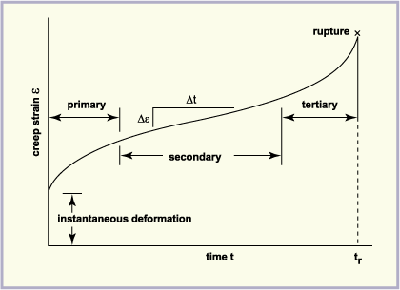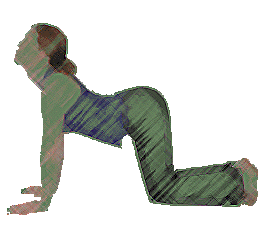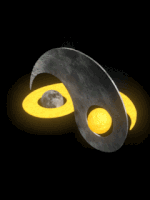By Bernie Clark, February 5th, 2016
 While we marinate in our yoga postures, changes happen deep within us. Whether in a long held posture or performing rhythmic stretches, our muscles elongate, until they reach the maximum length they can tolerate without damage. One of many causes preventing greater lengthening is the connective tissues surrounding and investing our muscles and our joints.[1] However, with continued stress these connective tissues begin to lengthen; they creep. How much and how fast our tissues creep may dictate what is a safe length of time we should linger in a pose, how much stress we should subject our tissues to and how quickly, and what movements we should do next.
While we marinate in our yoga postures, changes happen deep within us. Whether in a long held posture or performing rhythmic stretches, our muscles elongate, until they reach the maximum length they can tolerate without damage. One of many causes preventing greater lengthening is the connective tissues surrounding and investing our muscles and our joints.[1] However, with continued stress these connective tissues begin to lengthen; they creep. How much and how fast our tissues creep may dictate what is a safe length of time we should linger in a pose, how much stress we should subject our tissues to and how quickly, and what movements we should do next.
Creeps surround us! Not the kind that Radiohead sung about, but the slow elongation that many materials undergo when subjected to stress. If you have fixed a blob of silly putty to a wall over night, you may have awoken to find it elongated into a line of slime by morning (note the picture to the left which shows many days of silly putty creep.) Its plastic-like nature allowed it to undergo creep–it lengthens under the stress of its own weight. Ice creeps—a glacier may slowly deform and flow under its own weight. Concrete creeps, which is a good thing—the alternative is to crack under stress. Metal in buildings, bridges and airplanes creep as well–which is not so good in the long term; as the materials thin they weaken and the building may eventually break. Within our own body, our tissues also exhibit creep when subjected to stress, heat and time, but unlike concrete or metal, our creepy bodies can return to normal, and even get stronger.[2] 
To understand creep, it is useful to understand a few technical terms–stress, strain, and viscoelasticity. (To make this article a little easier to digest, deeper technical discussions will be covered in the footnotes.) In yoga we often talk about stretching our muscles, which is the verb, but we also talk about stretch as a noun, referring to how much extra length we have achieved. Scientists prefer to be more exact–they define stress to be the force placed upon a material (such as our muscles or fascia) and strain to be the amount of elongation the material exhibits, usually defined as a percentage of the original resting length. So stress is the force applied to our tissues and strain is the lengthening that occurs due to the stress.[3] (See the graph that shows the relationship between strain and time at a constant stress.) As we apply an external stress to tissues in one area, usually due to muscles contracting in another area or the pull of gravity, a balancing stress builds up within the tissues that exactly equals the external stress. Without this balance, the tissue would continue to lengthen until it ruptured. It is this inner stress that may initially stop further strain from developing, however, due to changes in our tissues over time, the inner stress decreases,[4] which allows the tissues to continue to lengthen. [5]
Viscosity is a term used to describe how easily a fluid can flow. Honey flows slowly out of a jar–it is more viscous than water, which flows quickly. A stretched elastic band returns to its original length once the stress is removed–it is elastic. Our tissues are not quite elastic but neither are they purely viscous–they are viscoelastic–they are both viscous and elastic. Under stress our tissues flow, lengthen, stretch. Once stretched our tissues remain a little bit longer than they were originally even after the stress is removed. In time, and it may take only few minutes or several hours, this extra length may disappear. How long that takes and how much creep is created depends upon several factors–the rate of the stress being applied (faster stress creates less strain in a viscoelastic material);[6] the temperature of the tissue (warmer tissues exhibit more creep than colder materials);[7] and the amount of time the stress is applied (the longer the stress is held, the more completely the material is deformed),[8] as well as the nature of the tissues undergoing stress (for example, fascia undergoes creep much more than bone). It is interesting to notice how these factors manifest in different yoga styles.
In an active power yoga or vinyasa/flow class, the stresses are quite dynamic and brief. There is little opportunity for the muscles and fascia to exhibit creep when the stresses are sharp, short and intense. However, the movements we make in these practices warm up the body considerably. The temperature of our muscles in our arms and legs is usually around 33° when we have not yet warmed up, but after several sun salutations the temperature can climb to around 39°. This increase in temperature increases viscoelasticity in our fascia, which means that our muscles are less limited by fascial resistance and the limb’s range of motion increases.[9] Our muscles are more elastic when warm than cold, which is why warming up before any sporting activity is always a good idea. The degree of creep in our fascia is higher when we are warmed up, which is another reason our range of motion is greater.
In a Hot Yoga class the temperature of the body is elevated due to the ambient temperature. When the room is hot, we don’t need much in the way of muscular warm ups to increase viscoelasticity. This heat in turn increases the amount of creep that can occur–the tissues do get noticeable longer–we are more flexible in a hot room than a cold one.
In a yin yoga class, the room is not hot, the body is not pre-heated by any exercise or movements, and the postures are entered slowly. But the poses are held for many minutes at a time, allowing creep time to flow to its maximum. One study found that “a time range of 240 seconds is sufficient to have an almost complete development of viscous phenomena. The stress-relaxation curves show that 90% of stress relaxation takes place in the first minute after the application of the strain.”[10] In other words, time can do the job just as well as heat. Holding a posture for 4 minutes or longer takes the tissues close to their maximum creep, with most of the creep happening in the first minute or two. (Of course that will vary with different people.)
When creep becomes creepy
 Creep can help hypomobile joints regain mobility, can help work through scar tissue and adhesions, and can help most people optimize their range of motion. This is why we warm up before sporting events–the larger range of motion of our joints and the increased compliance of our muscles prevents injury. However! You can do too much of anything. Hypermobile people should beware of creep, as should anyone suffering from connective tissue pathologies like Ehlers Danlos Syndrome. For these people, holding a pose for a long time, or in a hot environment, or subjecting their joints to a repetitive motion will increase the creep in their fascia, ligaments, joints capsules and tendons, which may not be healthy or desirable.
Creep can help hypomobile joints regain mobility, can help work through scar tissue and adhesions, and can help most people optimize their range of motion. This is why we warm up before sporting events–the larger range of motion of our joints and the increased compliance of our muscles prevents injury. However! You can do too much of anything. Hypermobile people should beware of creep, as should anyone suffering from connective tissue pathologies like Ehlers Danlos Syndrome. For these people, holding a pose for a long time, or in a hot environment, or subjecting their joints to a repetitive motion will increase the creep in their fascia, ligaments, joints capsules and tendons, which may not be healthy or desirable.
How long is too long? Every body is different, and older people tend to undergo larger creep and have longer recovery times.[11] Several studies have shown that after 20 minutes of passive stress the strain on the connective tissue can remain for several hours.[12] This means that, due to the increased length and reduced strength of the fascial tissues, these areas are not as stiff or stable as they originally were, and their ability to withstand even relatively normal or innocuous stress could lead to injury. To quote Stuart McGill, “Under sustained load these viscoelastic tissues slowly deform and creep …. [which] cause[s]a progressive reduction in the tissues strength.” He goes on to warn, “The associated creep … may initiate another chain of events. Stretched ligaments increase joint laxity, which can lead to hyperflexion injury … This laxity remains for a substantial period…”[13] Stuart McGill has studied workers who remained in a slouched or hunched position for many hours of their working day, subjecting their spines to a very long-held flexion. As the spine remained flexed, the posterior ligaments of the spine and the posterior fibers of the disc underwent creep from bearing a static load for many hours. If this continues, at some point the ability of these tissues to tolerate the load will be exceeded, and injury will occur.
Fortunately, no yoga practice requires remaining in one posture for hours. No yoga practice even requires a single posture to be held for 20 minutes,[14] and certainly not with a flexed spine or at the limit to one’s range of motion. But holding a position for 4 minutes in some cases can maximize the amount of creep a tissue is capable experiences.[15] For this reason, for some people, awareness of creep is important–if you have allowed your connective tissue to creep significantly, care and caution should be used when coming out of that position and in deciding what movements to do next.
Counterposes
 Varying amounts of creep can occur through repetitive (cyclical) movements, through warming up, through practicing in a hot yoga room, and through long held static stress.[16] In every case the tissues that experienced creep will take time to recover their original stiffness and length. Static stress (yin) increases creep faster than cyclical stress (yang).[17] Thus, yin yoga is more effective at generating creep than active yang yoga practices. This can be very good, and very therapeutic, but it does mean that yin yogis have to be more aware of the reality of creep, and to take care in deciding what to do after coming out of their postures. Sarah Powers defined the fourth principle of yin yoga to be, “coming out slowly.” There is a reason we feel so fragile after a yin pose–we have weakened and lengthened our fascia and joints. We need to take care how we move now.
Varying amounts of creep can occur through repetitive (cyclical) movements, through warming up, through practicing in a hot yoga room, and through long held static stress.[16] In every case the tissues that experienced creep will take time to recover their original stiffness and length. Static stress (yin) increases creep faster than cyclical stress (yang).[17] Thus, yin yoga is more effective at generating creep than active yang yoga practices. This can be very good, and very therapeutic, but it does mean that yin yogis have to be more aware of the reality of creep, and to take care in deciding what to do after coming out of their postures. Sarah Powers defined the fourth principle of yin yoga to be, “coming out slowly.” There is a reason we feel so fragile after a yin pose–we have weakened and lengthened our fascia and joints. We need to take care how we move now.
One study found that the amount of creep the spine experiences after 20 minutes of static flexion stress was 6.8 ~ 9.6%. After 20 minutes of recovery the amount of elongation had reduced to only 3 ~ 4%,[18] so less than half of the creep was gone after 20 minutes of relaxation. It takes longer for the tissues to recover their normal stiffness than the time that stress was applied. In some cases, it can take 7 hours or more for the tissues to fully return to normal stiffness.[19] The point to note is–time is needed after a long static stress to allow the creep that occurred to dissipate. This fact has a bearing on choosing our counterpostures and other activities after doing a yin yoga practice, or if you maintain a stressed position for a long time at your work.
Stressing an area that experienced significant creep by forcing it to bear weight is not a good idea. The tissues have become weaker and their tolerance to stress is reduced. Even bearing the body’s own weight could cause damage now. This would mean, don’t do weight training or handstands or any other muscularly demanding exercises right after a long yin practice. Allow time for the tissues to regain their stiffness. However, one way to reduce the amount of time required for the tissues to regain their original stiffness is to move the body in the opposite direction. That is the basis of using counter-postures in yoga. After a long period of spinal flexion, engage in mild spinal extension. For people who have been sitting for a long time, get up and walk around for a few minutes. Simply standing can help tissues recover more quickly.
Yin before yang, or yang before yin?
 There is no one right prescription that works for every body. Not every body will experience the same amount of creep and fragility in their fascia, but the general principles still make sense. Stress and creep are healthy for most people, but we can do too much. Give yourself time to recover before subjecting your body to dynamic, large stresses after you have been doing long-held static stresses. Do counter-movements to help speed up the recovery time. Do not rely only on a long shavasana; even a 20-minute shavasana may not be sufficient to remove all the creep that crept in during your practice.
There is no one right prescription that works for every body. Not every body will experience the same amount of creep and fragility in their fascia, but the general principles still make sense. Stress and creep are healthy for most people, but we can do too much. Give yourself time to recover before subjecting your body to dynamic, large stresses after you have been doing long-held static stresses. Do counter-movements to help speed up the recovery time. Do not rely only on a long shavasana; even a 20-minute shavasana may not be sufficient to remove all the creep that crept in during your practice.
If you want to do a yang practice and a yin practice together, it may be wise to interlace the two styles, with 10~15 minutes of yin postures followed by 5~10 minutes of yang movements; followed by another session of yin; then yang again, alternating but not going beyond 5 minutes in any one particular yin posture. This is not to say that 45 minutes of yin, followed by 45 minutes of yang is wrong, but care should be taken to make sure that you don’t stress the areas worked in the yin session when you do the yang practice. Work different parts–for example – if you worked the spine in your yin practice, do yang postures that do not require much movement or stress of the spine. Standing postures focusing on the legs may work best now. Keep the spine stiff, braced, and do not try for large range of spinal movements.
You could decide to do your yang practice first! That would build heat in the fascia and muscles which will make creep happen more quickly. However, warm muscles may reduce the amount of stress that soaks into the joint capsules.[20] Again, there is no right or wrong, there are just trade-offs and compromises. Try the alternatives for yourself and see which one works best for you.
Summary
Creep need not be creepy. We need to stress our tissues, and while they are stressed they undergo elongation and weakening. This is healthy and normal (for most people.) When the stress has ended, the tissues will slowly revert back to their original length and stiffness, and with a rest period they should become healthier and stronger than before. However, right after the stress has ended, before the tissues have returned to normal, there is a danger period in which the tissues could be overtaxed even by normal, every day activities. During this period, it is advisable not to demand a lot of these tissues. However, it is possible to shorten the time in which the tissues are potentially at risk–move gently in the opposite direction of the original stress and reduce the temperature of the tissues (coolness reduces creep). Yin yoga is especially good at generating creep, and we can sense the increased fragility of our tissues as we come out of the postures. Our own natural commonsense will warn us not to move too strenuously or quickly. But this feeling of fragility may soon go away even though the tissues are not yet back to normal. Take care; be aware; and go gently into your next activities.
Footnotes:
- — John Griffin, Client-Centered Exercise Prescription – 3rd Edition, page 244: 2015 Human Kinetics
- — Here we should differentiate plasticity and creep: plasticity implies a permanent elongation of our tissues once they have passed the tissues’ elastic limits. Creep on the other hand is a temporary lengthening that persists for a while after the stresses have ceased, but eventually the tissues regain their original length. Creep stresses do not take the tissues beyond their elastic limits so no permanent remodeling of the collagen fibers occurs, which is what happens under a plastic deformation of our tissues. When we take our connective tissues past their elastic limit, we rupture some of the connections between collagen fibers, and indeed we may break the fibers themselves. This can be therapeutic: these microfailures allow the tissues to permanently elongate, increasing range of motion. Over time the body creates new links between collagen fibers and replaces the broken fibers. Sometimes the existing fascial crosslinks are inappropriate (scar tissue or adhesions) and we need to break them. With creep, on the other hand, we don’t break the fibers or their connections, but the stress on the tissue causes water to be redistributed: water is squeezed out of the fascia into the spaces around the tissue. Water contributes to stability and stiffness in our tissues, making the tissues gel-like (like Jell-O). With less water in the tissues, there is less stiffness and less ability to resist stress, so further lengthening occurs–creep! When the external stress ceases, the water is slowly reabsorbed into the tissue and the tissue rebounds to its original length and stiffness. [See Fascia–Clinical applications for health and human performance by Mark Lindsay, pages 54-55: 2008, Delmar.]
Many researchers believe that the flow of water into and out of our connective tissue makes the tissues healthier. Robert Schleip talked about water in fascia absorbing free radicals, which can interfere with the healing process, but when the fascia creeps, some of this water is squeezed out of the fascia, along with their free radicals. When the tissue rehydrates later, the free radicals are left behind in the interstitial fluid where they can be more easily neutralized, thus our tissues are healthier. [See Robert Schleip, Lumbar Fasciae: A Frequent Generator of Back Pain. Latest Research Findings and Clinical Implication, presented at the Europäisches Symposium der traditionellen Osteopathie, February 7-10, 2013. ] - — Two other technical terms are often used in discussions of creep: stiffness and compliance. Stiffness is the ratio of strain to stress–as stress increases so does strain, but the rate of which strain increases is a measure of the material’s stiffness. A material that has a high stiffness does not exhibit much strain at increasing stresses, while a material that has low stiffness is said to be compliant: it is more elastic or stretches easily.
- — This decrease in the inner stress is technically called relaxation.
- — Two possible scenarios can play out when we hold a stress for time: either the strain increases under a constant stress (which means the tissues lengthens, which is what we are calling creep); or if the strain is held constant (we don’t lengthen any further), the internal stress decreases (which is relaxation.)
- — A viscoelastic material undergoes very little strain when a quick, sudden stress is applied. Our joints are quite stiff, not elastic at all, when subjected to a sudden force. This is a good thing and provides us with stability in the joints when we shock them with quick, intense stresses, such as jumping and running. When the stresses are smaller and slower, the connective tissues around the joint become more pliable and allow some stretching to occur. Fast, jumping, ballistic movements will not cause creep, but long held, static stress will. The rate of creep, for example, is faster during static spinal flexion compared to repetitive flexion. See Human Lumbar Spine Creep during Cyclic and Static Flexion: Creep Rate, Biomechanics, and Facet Joint Capsule Strain by Jesse S. Little and Partap S. Khalsa in Ann Biomed Eng. 2005 March ; 33(3): 391-401.
- — “Temperature increase in fascia of up to 40°C leads to reduced stiffness and more rapid elongation of the tissue, which in part can be attributed to higher extensibility of collagen.” From Temperatures effects on fascia by Werner Klingler–Fascia: the Tensional network of the human body, page 421: 2012 Churchill Livingstone Elsevier.
- — See Functional Atlas of the Human Fascial System, by Carla Stecco page 85: 2015 Churchill Livingstone
- — See Temperatures effects on fascia by Werner Klingler–Fascia: the Tensional network of the human body, page 421: 2012 Churchill Livingstone Elsevier.
- — Note: this does not mean that there is no more creep after 4 minutes. Creep will continue for a long time (see again the picture of silly putty creeping down the wall day after day.) The stress-relaxation reaching a maximum after 4 minutes means that the tissues won’t relax any further, but there is still some internal stress, which over time continues to cause creep. See Functional Atlas of the Human Fascial System, by Carla Stecco page 85: 2015 Churchill Livingstone
- — See Flexion creep deformation and hysteresis in the lumbar vertebral column by Twomey L, Taylor J. Spine 1982;7:116-122. [PubMed: 7089687]
- — See Stecco 2015 and Stuart McGill Low Back Disorders 3rd edition, pages 18-19: 2015 Human Kinetics
- — McGill 2015.
- — Several studies examining the consequences and extent of creep used 20 minutes as the average length of time to subject tissues to a stress and then measured the amount of strain that would occur and how long it would take for the tissues to return to their normal lengths. These studies were done in vitro, with cadaverous tissues, which meant that these tissues were not embodied in a normal, wet, living environment. These findings were caveated because we know that one facet of creep is the wringing out of moisture from the fascia and then its slow, subsequent re-hydration. The laboratory settings are not the same as in a living body and the 20 minute mark is a rather arbitrary amount of time: we cannot say that 20 minutes is the average time it takes for maximum creep to occur.
- — Again, see Stecco 2015.
- — Cyclical loading of the tissues does not create as much creep, nor do the tissues take as long to recover as occurs with static stress, most likely due to the fact that between each cycle of loading and unloading the tissues have some time to recover. One lesson we can draw from this observation for yin yoga is to modify our practice to have several shorter holds of the postures: to come into Butterfly for 2 minutes, come out and do another pose, the come back to Butterfly for another 2 minutes. By breaking up the postures into cyclical (but not dynamic) stress we may reduce the overall recovery time for hyperflexible people.
- — See Human Lumbar Spine Creep during Cyclic and Static Flexion: Creep Rate, Biomechanics, and Facet Joint Capsule Strain by Jesse S. Little and Partap S. Khalsa; published in Ann Biomed Eng. 2005 March ; 33(3): 391-401.
- — See Human Lumbar Spine Creep during Cyclic and Static Flexion: Creep Rate, Biomechanics, and Facet Joint Capsule Strain by Jesse S. Little and Partap S. Khalsa; published in Ann Biomed Eng. 2005 March ; 33(3): 391-401.
- — See Creep response of the lumbar spine to prolonged full flexion by McGill SM, Brown S. in Clin Biomech 1992;7:43-46.
- — See Cold Muscles – Warm Muscles in my book, YinSights and my article Hot Yin
